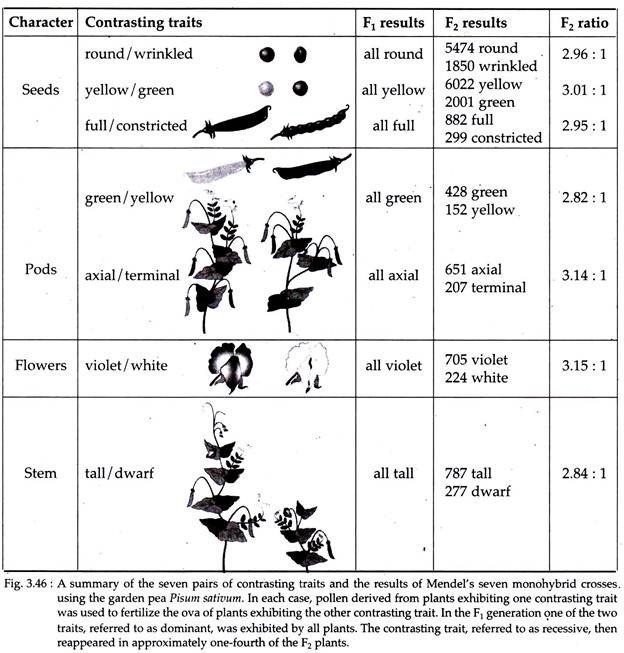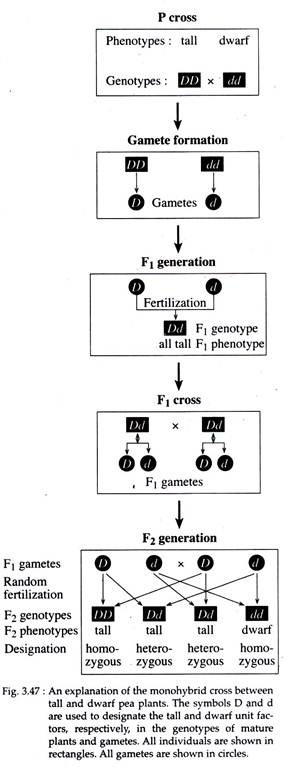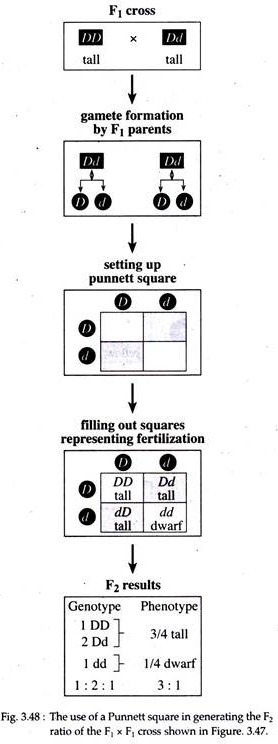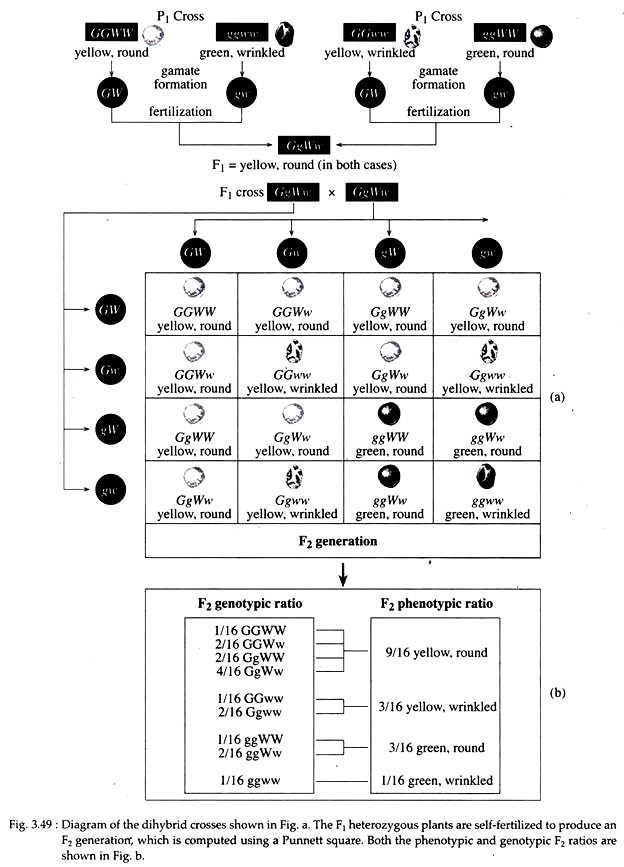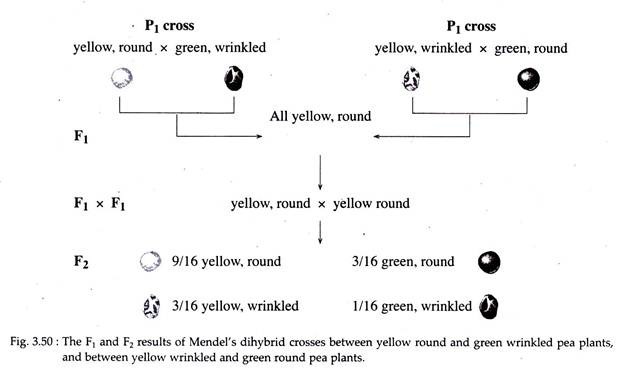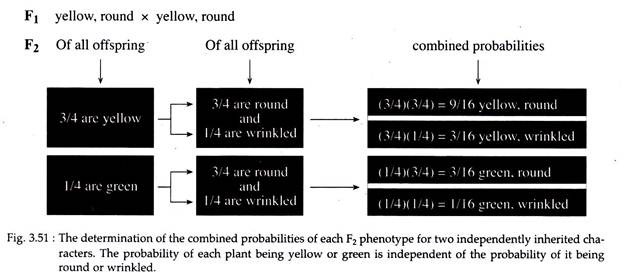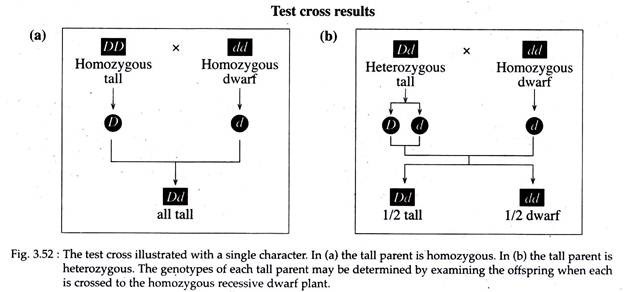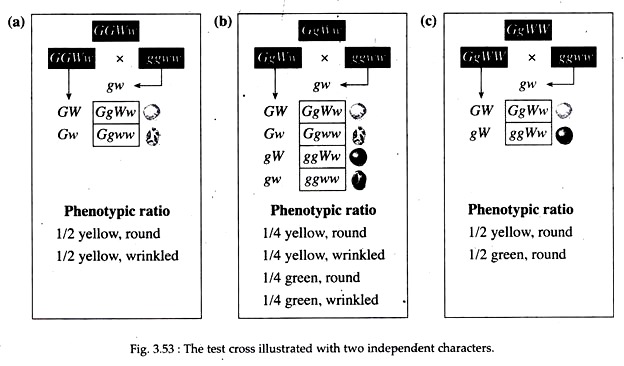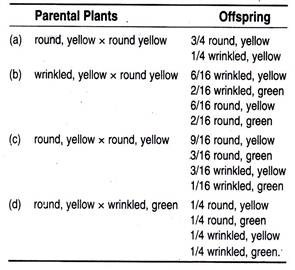The below mentioned article provides an overview on the Concept of Gene by Gregor Johann Mendel:- 1. Concept of Gene by Mendal 2. Monohybrid Cross 3. First Three Postulates 4. Analytical Approach of Gene 5. Modern Genetic Terminologies 6. Punnett Squares 7. Di-hybrid Cross 8. Independent Assortment 9. Test Cross 10. ‘Rediscovery’ of Principles 11. Problems.
Contents:
- Concept of Gene by Mendal
- Monohybrid Cross
- Mendel’s First Three Postulates
- Analytical Approach of Gene
- Modern Genetic Terminologies
- Punnett Squares
- Di-hybrid Cross
- Independent Assortment
- Test Cross
- ‘Rediscovery’ of Mendel’s Principles
- Problems in Mendel’s Concept
1. Concept of Gene by Mendal:
The concept of gene (but not the word) was first set forth in 1865 by Gregor Johann Mendel. Until then, little progress has been made in understanding heredity. For many reasons, the result of Mendel’s experiments went unappreciated until the turn of the last century, well after his death.
ADVERTISEMENTS:
Once Mendel’s publications were rediscovered by geneticists while investigating the function and behaviour of chromosomes, the implication of his postulates were apparent. Even today, Mendelian study of inheritance serves as the corner stone for the study of inheritance.
In 1856, Mendel performed his first set of hybridization experiments with garden pea. He reported the results of some simple genetic crosses between certain strains of garden pea in 1865. He chose garden pea, Pisum sativum, as it was easy to grow and hybridize artificially.
It is self-fertilizing in nature but easy to cross-breed experimentally. It reproduces well and grows to maturity in a single season. Mendel then chose seven visible features (unit characters), each represented by two contrasting forms or traits (Fig. 3.46).
For example, for the character stem height, he selected the traits tall and dwarf. The other six contrasting pairs of traits were seed shape and colour; pod shape and colour, and pod and flower arrangements (Fig. 3.46).
ADVERTISEMENTS:
From local merchants, Mendel obtained true-breeding strains, those in which each trait appeared unchanged, generation after generation in self-fertilizing plants. Mendel restricted his examination to one or very few pairs of contrasting traits in each experiment. From the analysis of his data, Mendel derived certain postulates that have become the principles of transmission genetics.
2. Monohybrid Cross:
Monohybrid cross was the simplest experiment that involved only one pair of any contrasting traits. The original parents in a genetic cross is called the P or parental generation, and their offspring’s are the F1 or first filial generation. If individuals of the F1 generation undergo self-fertilization, their offspring’s are called the F2 or second filial generation.
ADVERTISEMENTS:
In Mendel’s monohybrid cross, true tall plants were crossed with true dwarf pea plants. Tall and dwarf represent contrasting forms or traits of the character stem height. The resulting F1 generation consisted of only tall plants.
When members of the F1 generation were selfed or self-fertilized, Mendel observed that 787 of 1064 F2 plants were tall, while 277 of 1064 were dwarf — a ratio of approximately 2.84 : 1.0 or about 3 :1. Three-fourth appeared like the’ F1 plants, while one- fourth exhibited the contrasting trait, dwarfism, which had disappeared in the F1 generation (Fig. 3.47).
Mendel made similar crosses between pea plants exhibiting each of the other pairs of contrasting traits (Fig. 3.46). In every case, the outcome was similar to the tall and dwarf cross (Fig. 3.47). However, the crosses could be made either way — that is, pollen from tall plants pollinating dwarf plants, or vice versa. These are called reciprocal crosses. Therefore, the results of monohybrid crosses were not sex-dependent.
To explain these results, Mendel proposed the term unit factors, for each trait. He suggested that these factors are the basic units of heredity and are passed unchanged from generation to generation. Using the consisted pattern of results of the monohybrid crosses, Mendel derived the following three postulates or principles of inheritance that serve as the corner stone of the study of inheritance.
3. Mendel’s First Three Postulates:
i. Unit Factors in pairs:
A specific unit factor exists for each trait like tallness or dwarfness. Each diploid organism receives one factor from each parent. Three possible combinations may occur as the factor occur in pairs, two factors for tallness, two factors for dwarfness or one of each factor.
Any individual containing one of these three combinations, determines the stem height. So genetic characters are controlled by unit factors that exist in pairs in individual organism.
ADVERTISEMENTS:
ii. Dominance and Recessiveness:
The trait expressed in the F1 generation of the monohybrid cross, results from the presence of a dominant unit factor. The trait that is not expressed in the F1 but reappears in the F2 is due to the influence of a recessive unit factor.
So this dominance or recessiveness relationship pertains only when unlike unit factors are present together in an individual. In this case the trait tall stem is said to be dominant over the recessive trait, i.e., dwarf stem. So when two unlike-unit factors responsible for a single character are present in a single individual, one unit factor is dominant to the other, which is called recessive.
iii. Segregation:
When an individual contains a pair of like unit factors (two tall), then all gametes receive one tall unit factor. When an individual contains unlike unit factors (one tall and one dwarf), then each gamete has a 50% chance of receiving either tall or dwarf unit factor. So during gamete formation, the paired unit factors separate or segregate randomly, so that each gamete receives one or the other unit factor.
4. Analytical Approach of Gene:
Two contrasting traits exist for each character. How does one of the two traits or phenotypes disappear in F1 generation? Observation of F2 generation helps to answer this question. The recessive trait and its unit factor do not actually disappear in the F1 they are merely hidden or masked and reappear in one-fourth of the F2 offspring’s.
Therefore, Mendel concluded that one unit factor for tall and one for dwarf were transmitted to each F1 individual, but because the tall factor or allele is dominant to the dwarf factor or allele, all F, plants are tall. As shown in Fig. 3.47, Mendel deduced that the tall and dwarf alleles of the F1 heterozygote, segregate randomly into gametes.
If a large population of offspring is generated, the outcome of such a cross should reflect the ratio 3:1. Thus, Mendel’s analytical approach must be considered as a true scientific achievement on the basis of such simple but precisely executed breeding experiments. He proposed that discrete particulate unit of heredity exists and he also explained how they are transmitted from one generation to the next.
5. Modern Genetic Terminologies:
Modern geneticists have developed some useful terms in order to understand the monohybrid cross and Mendel’s first three postulates. Mendel’s unit factors represent units of inheritance — what modern geneticists now call genes.
So genes are the basic unit of heredity that contain the information for making one RNA and in most cases, one polypeptide. Any given character, like plant height, the phenotype is determined by different combination of alternative forms of a single gene called alleles. For example, tall and dwarf are alleles determining the height of pea plant.
The phenotype of an individual is what is perceived by observation, the organisms structure and function in short, or what a living being appears to be to our sense organ. The genotype is the sum total of the hereditary materials received by an individual from its parent and other ancestors.
When identical alleles constitute the genotype like DD or dd, the individual is said to be homozygous or a homozygote; when alleles are different Dd, the term used is heterozygous or heterozygote. The place where the genes reside on the chromosome is called locus (plural = loci), and alleles of a gene lie on the same locus of similar chromosomes.
6. Punnett Squares:
The genotypes and phenotypes resulting from the union of gametes during fertilization can be easily visualized by constructing a Punnett square, named after Reginald C. Punnett. In this approach, each of the possible gametes is assigned to an individual column or a row.
Usually the column represents gametes of the female parent and the row represents gametes of the male parent. Following the entry of the gametes in rows and columns, one can predict the new generation by combining the male and female gametic information for each combination and entering the resulting genotype in the boxes.
This process represents all possible random fertilization events. The genotypes and phenotypes of all potential offspring are ascertained by reading the entries in the boxes (Fig. 3.48).
The Punnett square method is very useful for the study of the phenotypic as well as genotypic ratios obtained from different crosses.
7. Di-hybrid Cross:
Cross involving two pairs of contrasting traits is called a di-hybrid cross or two factors cross. For example, pea plants having yellow coloured round seed were bred with those having green coloured wrinkled seeds. Here colour and shape are two characters of pea seeds.
Yellow and green are the contrasting traits of the former character while round and wrinkled are the contrasting traits of the second seed character. In this di-hybrid cross, F1 offspring’s are all yellow and round, indicating that yellow is dominant to green and round is dominant to wrinkled.
When these F1 individuals are selfed, about 9/16 of the F2 plants express yellow and round, 3/16 express yellow and wrinkled, 3/16 express green and round, and 1/16 express green and wrinkled. If plants with yellow wrinkled seeds are crossed to those with green round seeds, both the F1 and F2 results remain unchanged as shown in Fig. 3.49(a, b).
The results of a di-hybrid cross can be understood better if two monohybrid crosses are conducted separately. The chance of any plant having yellow or green seeds is not at all influenced by the chance that this plant will also have round and wrinkled seeds.
Thus, because yellow is dominant to green, all F1 plants in the first theoretical cross would have yellow seeds. In the second theoretical cross, all F1 plants would have round seeds because round is dominant to wrinkled. When Mendel examined the F1 plants of his di-hybrid cross, all were yellow and round, as predicted.
Similarly, the predicted F2 results of first cross are 3/4 yellow and 1/4 green, and the second cross should produce 3/4 round and 1/4 wrinkled. In the di-hybrid cross, 12/16 of all F2 plants are yellow while 4/16 are green, exhibiting the 3 : 1 ratio. Similarly, 12/16 of all F2 plants have round seeds while 4/16 have wrinkled seeds, again producing the 3 : 1 ratio, as shown in Fig. 3.50.
So two pairs of contrasting traits are inherited independently. When two independent events occur simultaneously, the combined probability of the two outcomes is equal to the product of their individual probabilities of occurrence. For example, the probability of an F2 plant with yellow and round seeds is (3/4) (3/4), or 9/16, because 3/4 of all F2 plants should be yellow and 3/4 of all F2 plants should be round.
Likewise, the probabilities of the other three F2 phenotypes: Yellow (3/4) and wrinkled (1/4) are predicted to be present together 3/16 of the time; green (1/4) and round (3/4) are predicted 3/16 of the time; green (1/4) and wrinkled (1/4) are predicted 1/16 of the time. The results are shown in (Fig. 3.51).
Now, it is apparent why F1 and F2 results are identical whether the parents of initial crosses are yellow round bred with green wrinkled or if they are yellow wrinkled bred with green round. In both crosses, the genotypes of all F1 plants are same; each plant is heterozygous for both gene pairs.
As a result, the F2 plants are also identical in both cases. From the results of di-hybrid crosses, Mendel proposed his fourth postulate.
8. Independent Assortment:
This postulate stipulates that any pair of unit factors segregate independently of all other unit factors. As a result of segregation, each gene receives one member of every pair of unit factors. For one pair, whichever unit factor is received, the outcome of segregation does not influence the other pair.
Thus, according to the postulate of independent assortment, during gamete formation, segregating pairs of unit factors assort independently of each other and all possible combinations of gametes will be formed in equal frequency.
9. Test Cross:
Mendel devised a rather simple method to test his hypothesis — the test cross. In this cross, the dominant phenotype with unknown genotype is crossed to a homozygous recessive individual. For example, as shown in Fig. 3.52a, a tall plant of DD genotype is test crossed to a dwarf plant with dd genotype, all offspring’s will be phenotypically tall with Dd genotype.
However, when a tall plant Dd is crossed to a dwarf (Fig. 3.52b) plant (dd), then one-half of the offspring’s will be tall (Dd) and the other half will be dwarf (dd). So a 1 : 1 ratio of tall and dwarf phenotype indicates the heterozygous nature of the tall plant having unknown genotype.’ This result also reinforced Mendel’s conclusion that there are separate unit factors for the control of different traits.
Two Characters:
The test cross may also be applied in di-hybrid cross. For example, if an F1 yellow round plant is crossed with the homozygous recessive green wrinkled plant (ggww), analysis of the offspring’s will indicate the exact genotypes of that yellow round plant. Three such cases are illustrated in Fig. 3.53.
10. ‘Rediscovery’ of Mendel’s Principles:
Mendel published his work on heredity in 1866 in Verhandlungen des Naturforschenden Vereines in Brunn, but his findings went largely unnoticed for about 35 years. To Mendel’s contemporaries, heredity included what we now know as genetics and embryology.
More pertinently, they also viewed heredity as simply a particular moment in development, and not as a distinct process requiring special analysis. By 1900, conceptions had changed enough that the significance of Mendel’s work was more apparent.
Near the end of the nineteenth century, a remarkable observation set the scene for the rebirth of Mendel’s work — Walter Flemming’s discovery of chromosome in 1879.
Since then, chromosome became an integral part of ideas surrounding inheritance and scientists started to re-examine Mendel’s findings. At about the turn of twentieth century three researchers, Carl Correns, Hugo de Vries and Erich von Tschermak worked independently on breeding experiments and came to the same conclusions as that of Mendel’s.
In 1902, two cytologists, Walter Sutton and Theoder Boveri pointed out that the separation of chromosomes during meiosis could serve as the cytological basis of Mendel’s postulates. They proposed the chromosomal theory of heredity.
Later on, different workers like Thomas H, Morgan, Alfred H. Sturtevant, Calvin Bridges and others established Stutton’s and Boveri’s hypothesis in many sexually reproducing organisms.
11. Problems in Mendel’s Concept:
i. In a cross between a black and a white guinea-pig, all members of the F1 generation are black. The F2 generation is made up of approximately 3/4 black and 1/4 white guinea-pigs.
(a) Diagram this cross, showing the genotypes and phenotypes.
(b) What will the offspring’s be if two F2 white guinea-pigs are mated?
(c) Two different mattings were made between black members of the F2 generation with the results shown below. Diagram each of the crosses.
ii. Mendel crossed peas having round seeds and yellow cotyledons (seed leaves)’with peas having wrinkled seeds and green cotyledons. All the F1 plants had round seeds with yellow cotyledons. Diagram this cross though the F2 generation using both the Punnett square and forked-line, or branch diagram, methods.
iii. Based on the same characters and traits as in Problem 2, determine the genotype of the parental plants involved in the crosses shown below by analyzing the phenotypes of their offspring.
iv. Which of the crosses in Problem 3 is a test cross?
v. Which of Mendel’s postulates can only be demonstrated in crosses involving at least two pairs of traits? State the postulate.
vi. In Drosophila, gray body colour is dominant to ebony body colour, while long wings are dominant to vestigial wings. Work the following crosses through the F2 generation and determine the genotypic and phenotypic ratios for each generation. Assume the P1 individuals to be homozygous.
(a) Gray, long x ebony, vestigial
(b) Gray, vestigial x ebony, long
(c) Gray, long x gray, vestigial.
vii. Mendel crossed peas with green seeds to those with yellow seeds. The Fi generation presented only yellow seeds. In the F2, the progeny consisted of 6022 plants with yellow seeds and 2001 plants with green seeds. Of the F1 yellow-seeded plants, 519 were self-fertilized with the following results: 166 bred true for yellow and 353 produced a 3 : 1 ratio of yellow : green. Explain these results by diagramming the crosses.
How many different types of gametes can be formed by individuals of the following genotypes?
(i) AaBb.
(ii) AaBB.
(iii) AABb, and
(iv) AABB.
